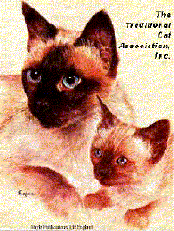|
HISTORY OF THE TRADITIONAL SELKIRK REX© CAT
Copyright, Diana Fineran May 2006
Breeders List
HISTORY
The breeds beginnings are connected with the efforts of a
Persian breeder, Jeri Newman of Bopeep Cattery, Livinton, Montana. Fascinated
with cat genetics, Jeri contacted friends and family to watch for any out of the
ordinary cat. Sure enough, in 1987 a customer, who had bought one of Jeriís
Persians, found an unusual, blue cream and white, female, curly kitten at the
For Petís Sake animal shelter in Sheridan Montana, where she worked and brought
the kitten to Jeri.
Quickly Jeri named the kitten Miss DePesto, due to her
tendency to pester Jeri for attention and follow her every where. Newman bred
Miss DePesto to her Black Persian male, Photo Finish of Deekay. The resulting
litter of six kittens had three kittens in it, who had the distinctive curls.
Experimentation continued with breeding Miss DePesto to her curly coated, black
and white son named Noface Oscar Kowalski. Three more curly kittens and one
long haired kitten were produced. The long haired kitten proved Miss DePesto
carried both the dominant curl gene and the recessive long hair gene. A second
litter of the same parentage produced a cruly red point kitten named Noface
Snowman of Manawyddan. This kitten proved Miss DePesto also carried the
recessive gene for the color point pattern.
Jeri Newman went on to add the British shorthair, American
Shorthair and Exotic Shorthair to the mix and began to promote the breed. With
the help of Carol Hovick and Sue Servies, who teamed up to form the QT Selkirk
Cattery in Monterey, California. A black and white Traditional Selkirk
shorthair, named Ditto, was one of their foundation cats. Another was named,
Piglet, by Hovick, because Piglet really liked to eat. Another founding breed
was Nancy McMullen of Oaktree Cattery in St. Paul, Minnesota.
The breed is well known for its sweet expression, large
size and exquisitely plush fur. One of the main features of the Traditional
Selkirk Rex is its curly coat. Unlike the other Rex breeds, the Devon and
Cornish, whoís coats are governed by recessives genes, the Traditional Selkirk
Rexís gene is dominant. This meant only one parent needs to possess the gene in
order for the curly gene to be expressed in the offspring. This creates the
paradox that makes the Traditional Selkirk Rex both easier and more challenging
to breed than a recessive gene variety.
The advantage is a breeder can see results right away. A
cat who has inherited the Curly gene from one parent will produce curly kittens
at an approximate ratio of one curly to one straight coated kitten.
The disadvantage of a dominant gene is that straight coated
kittens do not carry the curly gene at all. This slows down the breeding
process because only cats with the curly gene can be used in a breeding program.
The plus side is a cat receiving the curly gene from both
parents, which is called homozygous for the curly trait. This kind of cat is a
great boon to breeders because it can be used for out crossing and all the
resulting kittens will have the curly coat. It is also noted the fur of
homozygous cats is curlier and softer than the coats of cats who possess only
one copy of the gene.
All guard, down and awn hairs have a gentle curl, which is
more pronounced around the neck and tail. Even the whiskers are curly. Guard
hairs are slightly coarse, but the coat still feels soft and plush. Very dense
fur stands away from the body. The coat goes through several stages as the cat
grows. They are curly at birth, then loose the curliness and slowly re-acquires
it again at 8 to 10 months of age. A fully developed coat arrives at about 2
years of age. Climate, season and hormones, especially in females, can effect
the coat curl.
All colors are accepted, including pointed patterns.
There are both short hair and long hair divisions within
the breed with slight differences.
The short haired Traditional Selkirk Rex is medium in
length and arranged in loose, individual curls. The long hair version has long,
wavy hair that is longer than a Maine Coonís though not quite as long as a
Persians. Grooming the long hair isnít difficult, since the coat lacks the
light, fly away fur that causes matting.
PERSONALITY
Very social, they are sweet, laid back, gentle, cute, fun
loving and mellow, with generous amounts of love and affection for their
humans. Being people centered, they stay playful and kittenish even into
adulthood. They like to be where their people are, and donít do well in
isolation. In essence they love people. They make entertaining, affectionate
companions as well. Their mellow, tolerant personalities allow them to take
life as it comes with easy going patience. A good game of fetch, being held and
cuddled and even carried around on their peopleís shoulders is always enjoyed.
The seem to talk to people about their needs and they are very smart.
HEALTH
Breeders have not noticed any health problems associated
with the Traditional Selkirk Rex gene. The breed shows to be healthy and hardy.
They shed, just like any other cat and do require grooming,
but their fur doesnít mat as one would expect. Twice a week grooming works
best.
|

 The
Traditional Cat Association,
Inc.©1987ģTM
Official Website
The
Traditional Cat Association,
Inc.©1987ģTM
Official Website